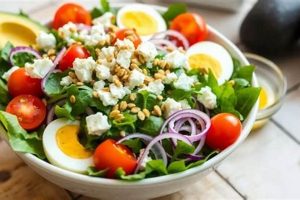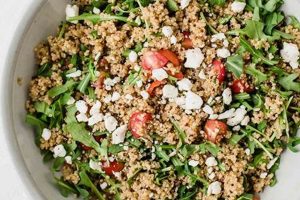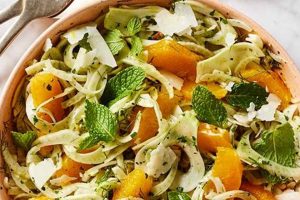A blend of various raw or cooked vegetables, often combined with other ingredients like legumes or grains, and dressed with a mayonnaise-based sauce constitutes a classic, customizable dish. For example, a simple version might include chopped carrots, celery, and peas, bound with mayonnaise and seasoned with salt and pepper. More complex variations can incorporate potatoes, green beans, hard-boiled eggs, or even fruits like apples or grapes, offering a broad spectrum of flavors and textures.
Such salads offer a convenient and refreshing way to consume a variety of essential vitamins, minerals, and dietary fiber. Historically, mayonnaise-based dressings have provided a palatable method for preserving and enhancing the flavors of otherwise bland or seasonal vegetables, increasing their appeal and contributing to balanced nutrition. The versatility of this dish allows for adaptation to individual preferences and dietary needs, making it suitable for various occasions, from everyday meals to festive gatherings.
This exploration will delve into the nuances of creating delicious and nutritious variations, covering topics such as ingredient selection, mayonnaise preparation, flavor balancing techniques, and presentation suggestions for optimal enjoyment.
Tips for Crafting Exceptional Vegetable Salads with Mayonnaise
Achieving a balanced and flavorful vegetable salad with mayonnaise requires attention to detail and a considered approach to ingredient selection and preparation. The following tips offer guidance for creating a truly satisfying culinary experience.
Tip 1: Vegetable Selection and Preparation: Opt for fresh, crisp vegetables. Thorough washing and appropriate cutting techniques, such as dicing or slicing, ensure even distribution of flavor and pleasing texture. Blanching certain vegetables, like green beans or broccoli, can enhance color and tenderness while preserving nutrients.
Tip 2: Mayonnaise Enhancement: While store-bought mayonnaise provides a convenient base, homemade versions offer greater control over flavor profiles. Experimenting with additions such as herbs, spices, citrus zest, or roasted garlic can elevate the dressing and complement the chosen vegetables.
Tip 3: Balancing Flavors and Textures: Consider incorporating contrasting textures and flavors. Crunchy vegetables like carrots and celery pair well with softer elements like cooked potatoes or chickpeas. The tanginess of pickled onions or olives can provide a welcome counterpoint to the richness of the mayonnaise.
Tip 4: Seasoning Appropriately: Seasoning plays a critical role in the final flavor profile. Salt and freshly ground black pepper are essential, but other seasonings like Dijon mustard, paprika, or celery seed can add depth and complexity. Taste and adjust seasonings throughout the preparation process.
Tip 5: Chilling and Serving: Chilling the salad allows the flavors to meld and enhances the overall experience. Serve chilled on crisp lettuce leaves or in a decorative bowl. Garnishing with fresh herbs or a sprinkle of paprika can add visual appeal.
Tip 6: Mindful Ingredient Proportions: Strive for a balanced ratio of vegetables to mayonnaise. Too much dressing can overwhelm the vegetables, while too little can result in a dry and less palatable salad.
Tip 7: Storage Considerations: Store leftover salad in an airtight container in the refrigerator for up to three days. Note that the texture of some vegetables may change slightly upon storage.
By adhering to these guidelines, one can create a vegetable salad with mayonnaise that is not only visually appealing but also nutritionally balanced and bursting with flavor.
These practical tips provide a solid foundation for creating a delectable salad. The subsequent section will explore specific recipe variations and offer further inspiration for culinary experimentation.
1. Fresh, High-Quality Vegetables
The foundation of any successful vegetable salad with mayonnaise rests upon the selection and utilization of fresh, high-quality vegetables. These ingredients contribute not only to the nutritional value but also to the overall texture, flavor, and visual appeal of the dish. The inherent flavors of fresh produce shine through when complemented by a creamy mayonnaise dressing, creating a harmonious balance. Consider the difference between a salad made with freshly picked, crisp lettuce versus one using wilted or less vibrant leaves. The former offers a satisfying crunch and clean taste, while the latter can detract from the overall experience. Similarly, using ripe, in-season tomatoes contributes a burst of sweetness and juiciness that canned or out-of-season tomatoes cannot replicate.
This principle extends to all vegetables incorporated into the salad. Freshly harvested carrots, cucumbers, and bell peppers retain their natural sweetness and contribute a vibrant color palette. Moreover, the texture of fresh vegetables plays a crucial role. A crisp cucumber or a crunchy radish provides textural contrast to softer elements like cooked potatoes or peas. This interplay of textures elevates the sensory experience of consuming the salad. Beyond the immediate sensory impact, fresh, high-quality vegetables offer a higher nutritional content, maximizing the health benefits of the dish.
Selecting and preparing fresh vegetables appropriately is therefore paramount. Careful washing, proper storage, and appropriate cutting techniques maintain both quality and visual appeal. Choosing seasonal produce ensures optimal flavor and nutritional value. Ultimately, prioritizing fresh, high-quality vegetables ensures a vegetable salad with mayonnaise that is not only visually appealing but also nutritionally sound and delivers a superior culinary experience.
2. Balanced Mayonnaise Dressing
A balanced mayonnaise dressing is crucial for a successful vegetable salad. It serves as the unifying element, binding the diverse flavors and textures of the vegetables while contributing its own distinct character. A well-balanced dressing complements rather than overwhelms the inherent flavors of the vegetables. Consider a salad featuring delicate spring greens and fresh herbs. A heavy, overly acidic mayonnaise dressing would mask the subtle flavors of these ingredients. Conversely, a lightly seasoned, creamy mayonnaise enhances the vegetables’ freshness without overpowering their delicate profiles. This balance hinges on the careful consideration of several factors: acidity, sweetness, richness, and texture. Acidity, often derived from vinegar or lemon juice, provides brightness and cuts through the richness of the mayonnaise. Sweetness, sometimes added with a touch of sugar or honey, balances the acidity and complements the natural sweetness of certain vegetables. The richness of the mayonnaise itself, derived from the emulsification of oil and egg yolks, provides a luxurious mouthfeel. Finally, texture is crucial; a smooth and creamy mayonnaise coats the vegetables evenly, while a thicker dressing might cling too heavily. Balancing these elements creates a dressing that enhances the overall sensory experience.
Real-world examples further illustrate this point. A classic potato salad relies on a tangy, slightly sweet mayonnaise dressing to complement the starchy potatoes and other ingredients like celery and onion. The acidity in the dressing prevents the salad from becoming bland, while the sweetness enhances the overall flavor profile. Similarly, a salad featuring roasted root vegetables benefits from a herbed mayonnaise dressing. The herbs add complexity and depth, complementing the earthy flavors of the roasted vegetables. In this case, a lighter mayonnaise base allows the roasted flavors to shine through. Failure to achieve a balanced dressing can negatively impact the final dish. An overly acidic dressing can make the salad unpleasant to consume, while a bland dressing fails to elevate the individual vegetable flavors.
Understanding the importance of a balanced mayonnaise dressing is fundamental to creating a successful vegetable salad. This balance, achieved through careful consideration of acidity, sweetness, richness, and texture, allows the individual flavors of the vegetables to shine while creating a cohesive and enjoyable culinary experience. Mastering this aspect of the recipe unlocks the full potential of this versatile dish, allowing for endless variations and culinary creativity.
3. Complementary Flavor Profiles
Complementary flavor profiles are essential to a successful vegetable salad with mayonnaise. The inherent diversity of vegetables allows for a wide range of flavor combinations, from the earthy sweetness of beets to the peppery bite of radishes. Mayonnaise, while providing a creamy base, can also be adapted to complement these diverse flavors. A fundamental principle lies in balancing contrasting yet harmonious tastes. For example, the sweetness of carrots and peas benefits from the tangy acidity of a dill-infused mayonnaise. The earthiness of roasted root vegetables pairs well with the herbaceous notes of a thyme or rosemary-infused mayonnaise. These pairings create a dynamic interplay, preventing any single flavor from dominating the palate. Conversely, a mismatch of flavors can result in a disharmonious experience. Pairing a delicate spring mix with a heavily spiced mayonnaise can overwhelm the subtle flavors of the greens. The goal is to create a synergy where each ingredient enhances the others.
Practical application of this principle involves careful consideration of both the vegetables and the mayonnaise. Starting with fresh, high-quality produce provides a solid foundation. Then, customizing the mayonnaise with complementary herbs, spices, or citrus zest creates a cohesive flavor profile. A salad featuring roasted sweet potatoes, for example, could benefit from a chipotle-lime mayonnaise, the smokiness of the chipotle complementing the sweetness of the potatoes while the lime adds brightness. Another example is a Mediterranean-inspired salad with cucumbers, tomatoes, and olives, paired with a lemon-herb mayonnaise. The bright citrus notes enhance the freshness of the vegetables and complement the briny olives. These examples illustrate how tailored flavor pairings elevate the sensory experience.
Achieving complementary flavor profiles in a vegetable salad with mayonnaise requires an understanding of the interplay between different tastes. Balancing contrasting flavors, such as sweet and tangy or earthy and bright, creates a dynamic and enjoyable experience. Careful selection of ingredients and thoughtful customization of the mayonnaise dressing are key to achieving this balance. This approach transforms a simple vegetable salad into a sophisticated culinary creation, showcasing the versatility and potential of this classic dish.
4. Appropriate Seasoning
Appropriate seasoning is fundamental to a successful vegetable salad with mayonnaise. It elevates the inherent flavors of the vegetables and the mayonnaise, creating a cohesive and balanced culinary experience. Seasoning not only enhances taste but also contributes to the overall complexity and depth of the dish. Understanding the role of different seasonings and their interplay with the other ingredients is crucial for achieving optimal results.
- Salt and Pepper:
Salt and freshly ground black pepper are foundational seasonings. Salt enhances the natural sweetness of vegetables and balances other flavors. Pepper adds a subtle heat and complexity. The quantity of each depends on the other ingredients and the desired flavor profile. Over-salting can mask delicate flavors, while insufficient pepper can result in a bland dish. A classic potato salad, for example, requires sufficient salt to season the potatoes and enhance the other ingredients, while a touch of black pepper provides a subtle bite.
- Herbs and Spices:
Fresh or dried herbs and spices add depth and complexity. Dill, parsley, and chives impart fresh, herbaceous notes, while paprika, cumin, and cayenne pepper offer varying levels of heat and earthiness. The choice of herbs and spices should complement the chosen vegetables. A Mediterranean-inspired salad might benefit from oregano and mint, while a Southwestern-style salad could incorporate chili powder and cumin. The quantity should be carefully considered; too much can overpower the delicate flavors of the vegetables, while too little may not provide the desired impact.
- Acids:
Acidity plays a critical role in balancing the richness of the mayonnaise and enhancing the brightness of the vegetables. Vinegar, lemon juice, or lime juice provide a tartness that cuts through the richness and adds a refreshing element. Different types of vinegar, such as apple cider vinegar or red wine vinegar, offer unique flavor profiles. Lemon juice pairs well with lighter salads, while lime juice complements dishes with bolder flavors. The amount of acid should be carefully balanced to avoid an overly tart or sour taste.
- Other Flavor Enhancers:
Ingredients like Dijon mustard, garlic powder, onion powder, or Worcestershire sauce can add nuanced flavors. Dijon mustard provides a tangy complexity, while garlic and onion powder contribute savory notes. Worcestershire sauce adds umami depth. These additions should be used judiciously to avoid overwhelming the primary flavors of the salad. For example, a small amount of Dijon mustard in the mayonnaise can add a subtle tang without overpowering the other ingredients.
Appropriate seasoning is the key to transforming a simple vegetable salad with mayonnaise into a well-balanced and flavorful dish. The careful consideration of salt, pepper, herbs, spices, acids, and other flavor enhancers ensures a harmonious blend of tastes. Each seasoning plays a specific role in enhancing the overall experience, contributing to a dish that is not only delicious but also reflects a thoughtful approach to culinary craftsmanship.
5. Optimal Chilling Time
Optimal chilling time plays a crucial role in the final quality of a vegetable salad with mayonnaise. Chilling allows the flavors of the various componentsvegetables, mayonnaise dressing, and any additional seasoningsto meld and harmonize. This process enhances the overall taste experience and contributes to the desired textural qualities of the salad.
- Flavor Development:
Chilling allows the individual flavors of the vegetables and the mayonnaise dressing to blend, creating a more cohesive and complex flavor profile. This is particularly important when using a variety of vegetables with distinct tastes, as the chilling period allows these flavors to marry and create a balanced overall taste. For example, the sharpness of onions or the sweetness of carrots can mellow and integrate with the other ingredients during chilling. A freshly made salad often tastes disjointed, with individual flavors competing rather than complementing one another. Optimal chilling allows these flavors to harmonize, creating a more unified and enjoyable culinary experience. The chemical processes involved in flavor development are temperature-dependent; chilling slows these processes, allowing for a gradual and balanced integration of flavors.
- Texture Enhancement:
Chilling affects the texture of both the vegetables and the mayonnaise. Many vegetables, especially leafy greens, benefit from chilling as it helps maintain their crispness. The cold temperature firms the cell walls, preventing wilting and maintaining a desirable texture. Mayonnaise-based dressings also benefit from chilling. The cold temperature solidifies the emulsion, creating a thicker and creamier consistency that adheres better to the vegetables. A warm mayonnaise dressing can be thin and runny, resulting in a less appealing texture and potentially separating from the other ingredients. The chilling process creates the desired textural contrast between the crisp vegetables and the creamy dressing.
- Food Safety Considerations:
Chilling is essential for food safety, particularly with mayonnaise-based salads. Mayonnaise, due to its ingredients, is susceptible to bacterial growth at room temperature. Chilling inhibits bacterial growth, minimizing the risk of foodborne illness. Maintaining a refrigerator temperature of 40F (4C) or below is crucial for ensuring food safety. This is particularly important for salads containing ingredients like potatoes or eggs, which are also susceptible to bacterial growth. Proper chilling safeguards the quality and safety of the salad, making it safe for consumption.
- Determining Optimal Chilling Time:
The optimal chilling time depends on several factors, including the specific ingredients and the desired outcome. A simple salad with a few ingredients might require only 30 minutes to an hour of chilling to allow flavors to meld and textures to firm. More complex salads with a variety of vegetables and a homemade mayonnaise dressing might benefit from longer chilling times, up to several hours or even overnight. Over-chilling, however, can have detrimental effects, potentially causing certain vegetables to become soggy or lose their vibrant color. The ideal chilling time balances flavor development, texture enhancement, and food safety considerations.
Therefore, optimal chilling time is integral to creating a vegetable salad with mayonnaise that is not only flavorful but also safe and texturally appealing. The chilling process enhances the overall dining experience by allowing flavors to meld, improving textures, and ensuring food safety. Understanding the impact of chilling on the various components of the salad allows for better control over the final product, contributing to a more satisfying culinary outcome.
6. Proper Storage Techniques
Proper storage techniques are essential for maintaining the quality, safety, and palatability of vegetable salad with mayonnaise. Mayonnaise, an emulsion of oil and egg yolks, is susceptible to spoilage and bacterial growth if not stored correctly. Vegetables, particularly leafy greens, are prone to wilting and loss of texture if exposed to improper storage conditions. Therefore, appropriate storage practices are crucial for preserving the intended flavors and textures, maximizing shelf life, and mitigating food safety risks. Improper storage can lead to undesirable outcomes, such as a sour or rancid taste in the mayonnaise, wilted and soggy vegetables, and potential bacterial contamination, rendering the salad unsafe for consumption.
Several factors influence the effectiveness of storage techniques. Temperature control is paramount; maintaining a refrigerator temperature of 40F (4C) or below inhibits bacterial growth and slows enzymatic processes that lead to spoilage. Airtight containers are crucial for preventing oxidation and moisture loss, preserving the freshness of both the vegetables and the mayonnaise. Properly sealed containers also minimize the risk of cross-contamination from other foods in the refrigerator. The duration of storage also affects quality. While refrigeration slows spoilage, vegetable salads with mayonnaise are best consumed within three to four days to maintain optimal flavor and texture. Beyond this timeframe, even with proper storage, the quality of the salad may deteriorate, and the risk of bacterial growth increases. Practical examples illustrate the importance of proper storage. A salad left at room temperature for an extended period, especially in warm weather, can become a breeding ground for bacteria, posing a significant health risk. Conversely, a salad stored in an airtight container in a properly functioning refrigerator retains its freshness and flavor for a longer duration. Similarly, storing cut vegetables separately from the mayonnaise dressing until just before serving can prevent them from becoming soggy, maintaining their desirable texture.
In conclusion, proper storage techniques are integral to the success of a vegetable salad with mayonnaise recipe. These techniques preserve the intended flavors and textures, extend shelf life, and ensure food safety. Temperature control, the use of airtight containers, and mindful storage duration contribute significantly to maintaining quality. Neglecting these practices compromises the sensory experience and poses potential health risks, highlighting the practical significance of understanding and implementing proper storage techniques.
7. Creative Presentation
Creative presentation elevates a vegetable salad with mayonnaise from a simple dish to a visually appealing culinary creation. While flavor and freshness remain paramount, visual appeal significantly enhances the dining experience. Consider the impact of a thoughtfully arranged salad compared to a haphazardly tossed mixture. The former invites enjoyment, stimulating appetite and enhancing perceived value. This connection between presentation and perception influences not only individual enjoyment but also the success of larger gatherings, where food often serves as a centerpiece. A visually appealing salad becomes a conversation starter, contributing to the overall ambiance.
Several techniques contribute to creative presentation. Utilizing a variety of colors, textures, and shapes adds visual interest. Consider a salad featuring vibrant green spinach, deep red beets, bright orange carrots, and creamy white cauliflower. This color palette alone stimulates the senses. Adding textural elements, such as crunchy nuts or croutons, further enhances the experience. Thoughtful plating techniques also play a crucial role. Instead of simply piling the salad onto a plate, consider layering ingredients or arranging them in distinct sections. Using different serving vessels, such as individual bowls or a large platter, can also impact visual appeal. Garnishing with fresh herbs or edible flowers adds a final touch of elegance. These elements demonstrate an attention to detail that elevates the perceived value of the dish.
The practical significance of creative presentation extends beyond aesthetics. It can influence eating habits, especially among children. A visually appealing salad can entice picky eaters to try new vegetables, contributing to healthier dietary choices. In professional settings, such as catered events or restaurants, creative presentation differentiates offerings and enhances the establishment’s reputation. A well-presented salad signifies culinary expertise and attention to detail, creating a positive impression. Furthermore, creative presentation can increase the perceived value of a dish, justifying higher prices in commercial settings. However, it’s crucial to maintain a balance between creativity and practicality. Overly elaborate presentations can be time-consuming and may detract from the focus on fresh, high-quality ingredients. The ultimate goal is to enhance the dining experience without sacrificing the integrity of the dish itself.
Frequently Asked Questions
This section addresses common inquiries regarding vegetable salads with mayonnaise, offering practical guidance and clarifying potential misconceptions.
Question 1: How long can a vegetable salad with mayonnaise be safely stored in the refrigerator?
Properly stored in an airtight container at 40F (4C) or below, a vegetable salad with mayonnaise is typically safe to consume for three to four days. Beyond this timeframe, quality degrades, and the risk of bacterial growth increases.
Question 2: Can one freeze a vegetable salad with mayonnaise?
Freezing is not recommended. Mayonnaise separates upon thawing, resulting in an undesirable texture. Vegetables with high water content also become mushy after freezing.
Question 3: What are suitable alternatives to mayonnaise in a vegetable salad?
Alternatives include plain yogurt, Greek yogurt, or sour cream, each offering a distinct flavor profile. Various vinaigrette dressings, based on olive oil or other vegetable oils, provide a lighter, non-dairy option.
Question 4: How can one prevent a vegetable salad with mayonnaise from becoming watery?
Thoroughly drying vegetables after washing and adding watery vegetables like tomatoes just before serving helps minimize excess moisture. Salting certain vegetables, such as cucumbers, and allowing them to drain before adding them to the salad can also reduce water content.
Question 5: What are some strategies for enhancing the nutritional value of a vegetable salad with mayonnaise?
Incorporating nutrient-rich vegetables like spinach, kale, or broccoli boosts vitamin and mineral content. Adding legumes, such as chickpeas or lentils, increases protein and fiber. Using a homemade mayonnaise with healthy oils, like olive oil or avocado oil, can further enhance nutritional value.
Question 6: Can one prepare a vegetable salad with mayonnaise in advance for a large gathering?
Advance preparation is possible. Prepare the vegetables and the mayonnaise separately, storing them in airtight containers in the refrigerator. Combine them shortly before serving to maintain optimal texture and prevent the salad from becoming watery. Consider chilling serving bowls or platters beforehand to maintain the salad’s temperature.
Understanding these key aspects ensures both a safe and enjoyable culinary experience. Careful ingredient selection, appropriate storage, and thoughtful preparation techniques contribute significantly to successful preparation and consumption of vegetable salads with mayonnaise.
The subsequent section will offer a collection of sample recipes, demonstrating the versatility and adaptability of this classic dish.
Conclusion
Exploration of vegetable salad with mayonnaise recipes reveals a dish offering both simplicity and culinary depth. Emphasis on fresh, high-quality ingredients, balanced mayonnaise dressing, complementary flavor profiles, appropriate seasoning, optimal chilling, proper storage, and creative presentation contributes significantly to a successful outcome. From everyday meals to festive gatherings, adaptability to individual preferences and dietary needs underscores the dish’s versatility.
Culinary experimentation with diverse vegetable combinations, customized mayonnaise variations, and innovative presentation styles offers a pathway to explore flavors and textures. Prioritizing fresh ingredients and mindful preparation elevates this seemingly simple dish to a satisfying and nutritious culinary experience.






